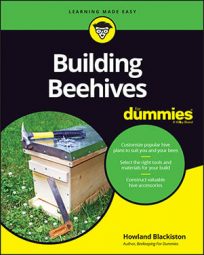The best woods for beehives
A handful of woods are used most frequently for making beehives. Sometimes the choice is regional (selecting a wood that’s readily available in your area), sometimes the choice is financial (selecting a wood because it’s the lowest price), and sometimes the choice is based on durability (selecting a wood because it stands up to the elements better than other woods).-
Pine: Hands down, this is the most widely used choice. It’s readily available everywhere, it’s among the least expensive lumber to purchase, and it’s easy to work with. Note that there are different grades of pine. Two are of interest here:
-
Knotty (sometimes referred to as standard pine): The knotty grade of pine is the least expensive and is perfectly sound for building, but it does contain knots and some other cosmetic imperfections. If you can live with a more rustic-looking hive, by all means go for the standard grade and save a few bucks.
You may need to order a little more material than stated in the plans, as the knots sometimes fall right where you plan a critical piece of joinery. So having a little extra material allows you to choose an alternate piece of wood without the offending knot.
-
Clear (sometimes referred to as select or premium pine): The clear grade is pricier. As the name suggests, this grade is clear of knots and other blemishes. The grain of the wood also tends to be tighter and straighter. It makes for a very nice looking, defect-free hive.
Pine isn’t the most durable wood to weather the elements, so you must protect pine with some coats of outdoor-quality paint, exterior polyurethane, or marine varnish.
-
-
Cypress: The cypress tree produces a sap-type oil that preserves the wood and naturally repels insects and mold. So, cypress is a terrific wood for making beehives and beekeeping equipment. But with most of the wood coming from southern states in the United States, it’s not readily available all across the country.
If you can get your hands on some cypress, you won’t be disappointed in the results. It’s a beautiful and naturally durable wood for building beehives.
-
Cedar: Cedar is a beautiful wood, and it smells divine. The natural oils make it less prone to warping, less susceptible to bug infiltration, and less likely to rot than other woods. Though you can paint it, you certainly don’t have to because of its naturally durable qualities. Left untreated it will weather to a lovely, light gray patina.
Frankly, were it not for the fact that it’s more expensive than pine, many would use it for every beehive. Many varieties of cedar exist, and depending on where you live, cedar lumber can sometimes be tricky to find. Western red cedar is the most widely available type across the United States.
-
Spruce and fir: Pine, spruce, and fir trees are all conifer trees. But when it comes to nomenclature in the lumberyard, spruce and fir are typically associated with stud lumber (versus board lumber). Some hive plans make use of spruce or fir studs (either spruce or fir is fine, as they’re interchangeable) that you use for making frames, top bars, and some other applications.
Synthetic wood for beehives
Environmentally friendly, synthetic wood is made from a blend of recycled plastics, sometimes combined with wood fibers. It’s quite remarkable stuff. It’s completely weatherproof, will never rot, and is essentially maintenance-free (just wash it clean). In recent years it has gained popularity as a very durable decking material.The jury’s out when it comes to making beehives with this stuff. For one, it’s not available in all standard lumber sizes, so making a full-blown hive may be a challenge. Also, it’s astonishingly heavy and seriously expensive.
Exotic wood for beehives
If you want to knock someone’s socks off with an over-the-top beehive or hive-top feeder, consider splurging and making one out of a high-grade or exotic wood. Cherry wood makes stunning kitchen cabinets — why not a cherry wood beehive?Langstroth hives using African mahogany have been seen selling for $1,500 each! There are also beautiful black walnut observation hives. They look more like a fine piece of furniture than a beehive. The choice of wood is up to you.
These fancy schmancy hives may not be any more functional, and perhaps even less practical, but if you’re making hives to sell or just like having something unique, give it a go. Keep in mind, however, that your sweet bees don’t know the difference between ponderosa pine and golden-grain Macassar ebony.
Woods to be wary of for beehives
Some beekeepers talk about woods that may be toxic to bees and therefore shouldn’t be used to make hives. Black walnut might be one such wood. It's hard to find any hard evidence of a natural wood that has been proven toxic to honeybees.However, the sawdust created when working with some woods can be toxic or allergenic to the woodworker (examples are black walnut, mahogany, and cedar). But there’s no evidence that these or other woods are problematic to the bees. Chances are that any of the woods you can get your hands on are okay for making hives and equipment.
The one possible exception is pressure-treated wood. It doesn't seem like a good idea exposing bees to chemicals. Although since 2004, this category of wood product no longer uses toxic copper, chromium, and arsenic (CCA) to protect it from insects and mold. The new recipe is supposed to be safe. But if you'd rather not take a chance with your girls, stick to the all-natural, untreated wood.

